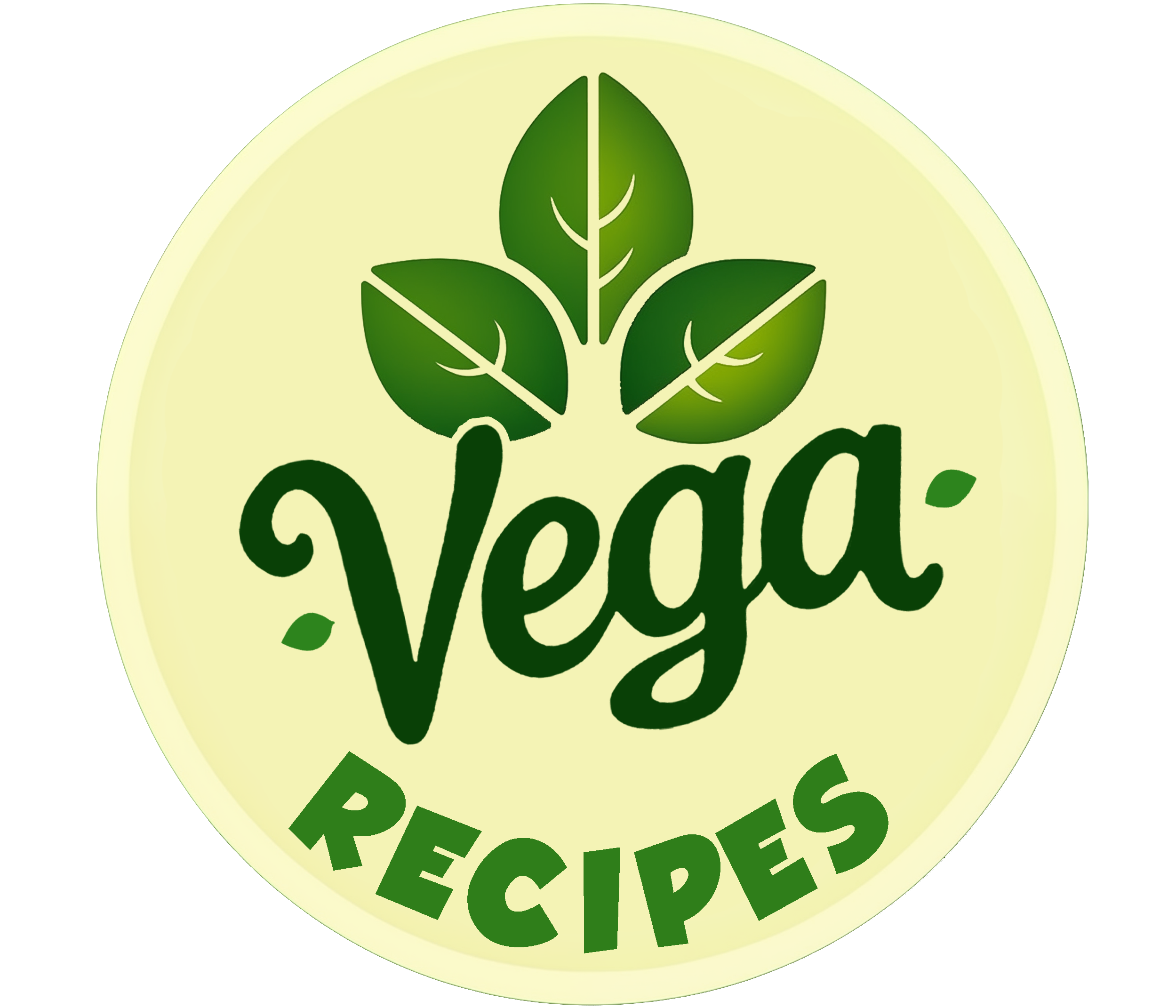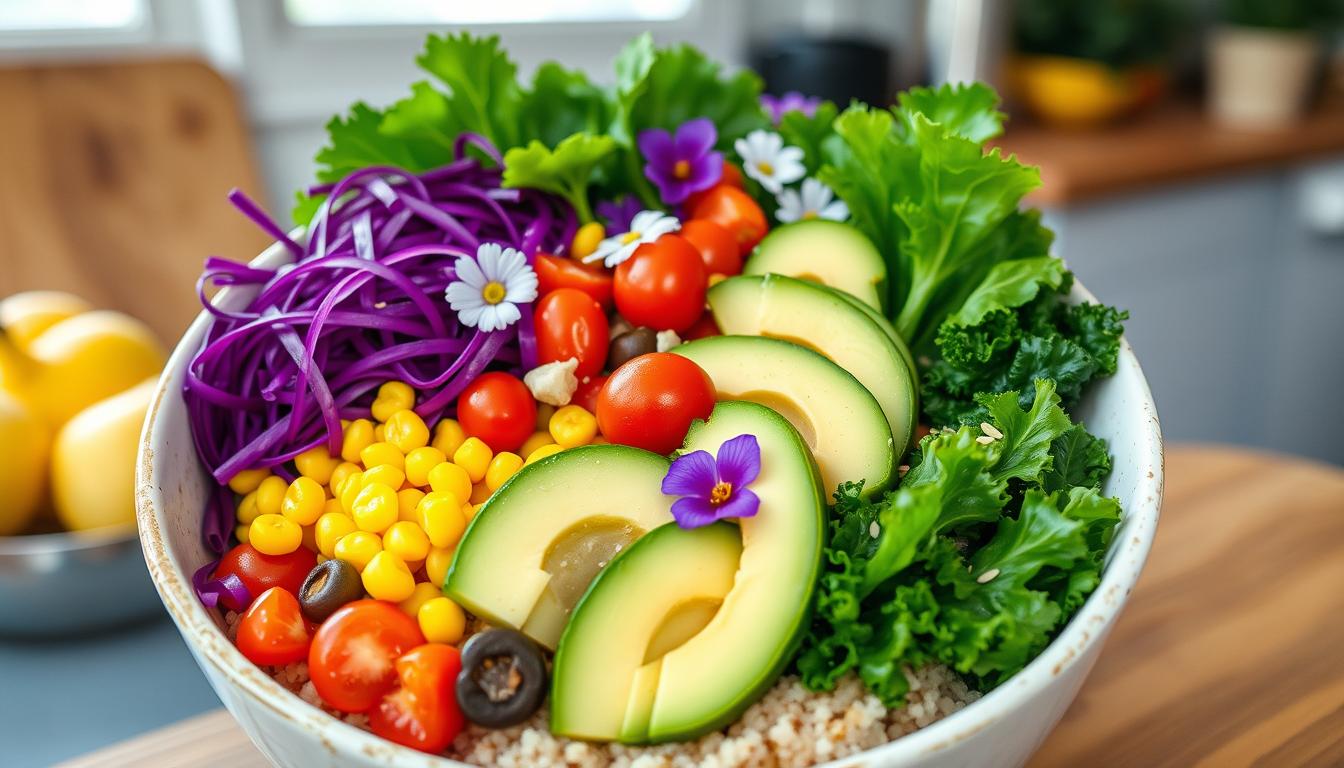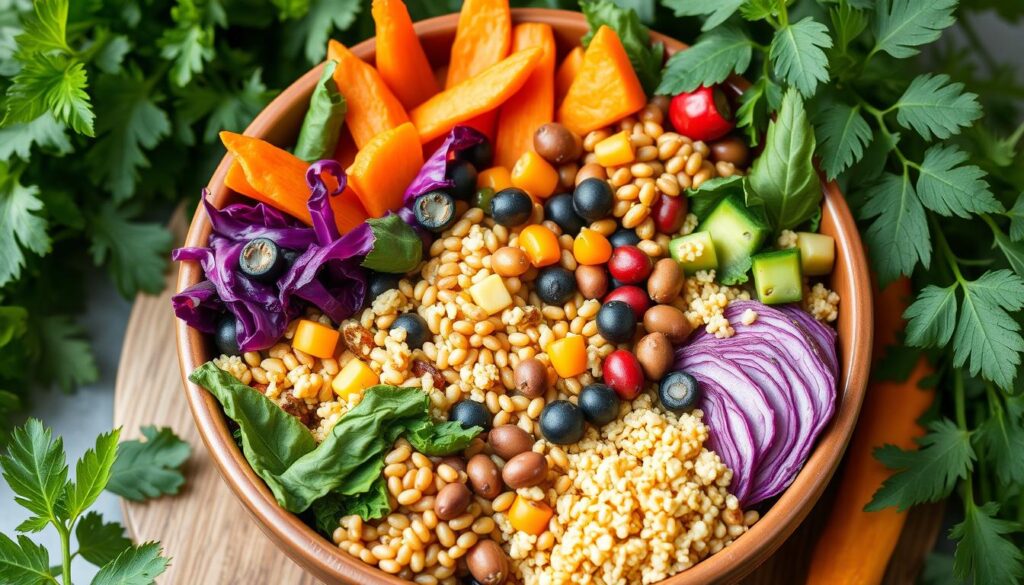Ever thought about how color can make your meals better and healthier? The Vegan Rainbow Buddha Bowl is a vibrant dish that shows the power of « eating the rainbow. » It uses many colorful foods to excite your taste and increase your nutrient intake. In just 50 minutes, you can make a Healthy Buddha Bowl Recipe with seasonal veggies, protein-rich quinoa, and a tasty homemade dressing.
As we dive into this colorful dish, you’ll see how each part makes it both nourishing and beautiful.
Key Takeaways
- The Vegan Rainbow Buddha Bowl promotes health through a variety of colorful vegetables.
- Preparation takes only 50 minutes, perfect for a quick, nutritious meal.
- This dish is gluten-free and kid-friendly due to its appealing presentation.
- Each serving offers essential vitamins and minerals essential for a balanced diet.
- Customizations and variations make this bowl suitable for any palate.
What is a Rainbow Buddha Bowl?
A Rainbow Buddha Bowl is a colorful mix of foods that looks great and is good for you. It has grains, veggies, and proteins from plants. For example, quinoa is often at the base, topped with carrots, zucchini, and beets.
This dish is all about variety. It lets you get creative in the kitchen, using what you like or what’s in season. Making a vegan Buddha bowl is fun and good for you. It’s like a rainbow of nutrients, making sure you get all the vitamins and minerals you need.
| Nutritional Value | Per Serving |
|---|---|
| Calories | 461 kcal |
| Carbohydrates | 52 g |
| Protein | 18 g |
| Fat | 23 g |
| Saturated Fat | 3 g |
| Sodium | 164 mg |
| Potassium | 1081 mg |
| Fiber | 13 g |
| Sugar | 5 g |
| Vitamin A | 5548 IU |
| Vitamin C | 29 mg |
| Calcium | 122 mg |
| Iron | 5 mg |
This dish is packed with nutrients and is great to have 2-3 times a week. It’s more than just a meal; it’s a way to live a healthy lifestyle through eating well.
Benefits of Eating a Rainbow Buddha Bowl
Eating healthy can really change how you feel, and a Rainbow Buddha Bowl is a great example. It’s full of colorful foods that look good and are good for you. Each colorful veggie adds important vitamins, minerals, and antioxidants, making your diet balanced.
Quinoa is a key part of many Buddha Bowls. It’s a complete plant-based protein, meaning it has all nine essential amino acids. It’s also packed with fiber, magnesium, and B vitamins, helping with digestion and energy.
Adding whole foods to your meals can spark creativity and mindfulness. Choosing and arranging ingredients can make cooking more enjoyable. When I make my Rainbow Buddha Bowl, I love the mix of colors and textures. It shows that eating should be a fun and healthy experience.
| Ingredient | Health Benefit |
|---|---|
| Quinoa | Complete protein source, high in fiber |
| Kale | Rich in vitamins A, C, and K, antioxidants |
| Carrots | High in beta-carotene, supports vision |
| Radishes | Contains vitamin C and promotes digestion |
| Bok Choy | Low-calorie vegetable, source of calcium and iron |
Choosing plant-based meals is good for the planet and for you. It’s rewarding to pick ingredients that are both vibrant and healthy. It shows my commitment to a healthier lifestyle.
Ingredients for a Rainbow Buddha Bowl
A Rainbow Buddha Bowl is made with many tasty and healthy vegan ingredients. It needs grains, proteins, colorful veggies, and fats. Quinoa or brown rice are great grains to start with.
Chickpeas are a top protein choice, adding texture and taste. Avocado brings creaminess and important nutrients.
Essential Ingredients for a Vegan Buddha Bowl
- 1 cup of quinoa
- 2 (19 oz) cans of chickpeas
- 4 mini cucumbers
- 1 cup of mixed olives
- 16 medjool dates
- 1 avocado
- 2 tomatoes or 1 red bell pepper
- 2 carrots or ½ boiled sweet potato
- 1 handful of spinach or ½ cucumber
Recommended Variations and Add-ins
I like to make my Rainbow Buddha Bowl my own by trying new things. Roasted sweet potatoes or edamame add flavor and texture. Sesame seeds or almonds give a nice crunch.
Trying different dressings, like tahini or lemon, lets me change up the taste. It’s all about mixing and matching to find what I like best.
How to Make a Rainbow Buddha Bowl
Making a Rainbow Buddha Bowl is fun and colorful. I start with a healthy base like quinoa or brown rice. Then, I chop and prep many colorful veggies. Each part is important for a tasty and healthy meal.
Step-by-Step Preparation Instructions
To make a buddha bowl, follow these easy steps:
- Rinse 1 cup of quinoa in water to remove bitterness. This makes the quinoa fluffy.
- In a pot, mix the rinsed quinoa with 2 cups of water. Bring it to a boil.
- Lower the heat and cover. Let it cook for 15-20 minutes until all water is gone.
- Fluff the quinoa with a fork and let it cool.
- Chop your favorite veggies like kale, radishes, carrots, and bell peppers. You can eat them raw or roast them for more flavor.
- Layer your bowl with quinoa, greens, colorful veggies, and protein like chickpeas or tofu.
- Drizzle your favorite dressing on top for extra taste.
Tips for Cooking Quinoa Perfectly
For perfect quinoa, follow these tips:
- Rinse quinoa under cold water before cooking.
- Use a 2:1 water-to-quinoa ratio for the right texture.
- Cook it with a lid on to steam the grains evenly.
- Turn off the heat when all water is absorbed. Let it sit for a few minutes covered.
Vegan Rainbow Buddha Bowl Recipe: A Colorful and Nutritious Delight
This vegan rainbow buddha bowl recipe is not just pretty. It’s also packed with nutrients. It includes colorful veggies, grains, and healthy fats for a balanced meal. Here’s a list of the main ingredients and how to put your bowl together.
Main Ingredients Used in the Recipe
- 1 cup cooked quinoa (providing about 8g of protein)
- 1 can of chickpeas (15 oz), approximately 3.75 servings (~8g protein per serving)
- 1 cup shredded red cabbage (a source of Vitamin K)
- 2 julienned carrots (high in Vitamin A)
- 1 sliced red bell pepper (contributes Vitamin C and Vitamin A)
- 1 sliced yellow bell pepper (contributes Vitamin C and Vitamin A)
- 1 sliced avocado (provides healthy fats, ~15g fat)
- 2 cups fresh spinach (rich in folate and Vitamin K)
- 2 tablespoons olive oil (provides ~28g fat)
- 1/4 cup tahini (adds ~10g fat from sesame seeds)
Instructions for Assembly
To make a buddha bowl, follow these easy steps:
- Begin with a big pile of fresh spinach as the base.
- Put cooked quinoa on top of the greens.
- Arrange each veggie—red cabbage, carrots, bell peppers, and avocado—on the quinoa for a rainbow look.
- Add your protein, like roasted chickpeas or tofu, on top.
- Drizzle tahini dressing over everything to add flavor and bring it all together.
- Top with sesame seeds or microgreens for extra texture and a nice finish.
Creating Your Own Buddha Bowl
Making a custom Buddha Bowl is a fun way to show off my taste and health goals. I start with a base of whole grains or legumes. Quinoa or chickpeas are great for plant-based protein.
Next, I pick a variety of seasonal veggies for color and texture. Snap peas or red cabbage add a nice crunch.
To add protein, I choose edamame or nuts like sesame seeds. A drizzle of extra-virgin olive oil brings out the flavors. This lets me experiment with new tastes and textures.
Here’s a chart to help you make your own Buddha Bowl:
| Component Type | Suggestions | Examples |
|---|---|---|
| Base | Whole grains or legumes | Brown rice, quinoa, chickpeas, lentils |
| Vegetables | Seasonal and colorful | Spinach, broccoli, bell peppers, carrots |
| Protein | Plant-based options | Edamame, tofu, vegan feta |
| Toppings | Seeds and nuts | Sesame seeds, hemp seeds, pumpkin seeds |
| Dressing | Flavorful options | Carrot-ginger dressing, tahini dressing |
By mixing these ingredients, I can make a Buddha Bowl that’s just right for me. Each bowl is a special meal that shows off my taste. It makes cooking fun and eating rewarding.
Exploring Different Dressings for Your Bowl
The right dressing can make a Rainbow Buddha Bowl even better. It blends flavors in a way that makes the meal more enjoyable. Dressings like tahini, balsamic vinaigrette, and avocado dressing are great choices. Tahini adds a creamy, nutty taste. Balsamic vinaigrette, on the other hand, adds a tangy kick.
Choosing the right dressing changes how we taste the meal. It also makes the meal more fun to eat.
Popular Vegan Dressings to Enhance Flavor
Here are some top vegan dressings:
- Tahini-based dressings: These are creamy and nutty.
- Balsamic vinaigrette: It’s tangy and balances sweet veggies.
- Avocado dressing: It’s creamy and filling.
- Sesame-ginger dressing: It has a unique flavor that goes well with grains.
- Spicy dressings: Like spicy Dijon mustard and Sriracha, add excitement.
Homemade Tahini Dressing Recipe
Making tahini dressing is simple. Here’s how to do it:
- Start with 1/4 cup tahini and 2 tablespoons lemon juice in a bowl.
- Add 1 clove minced garlic and 1 tablespoon maple syrup for sweetness.
- Then, mix in 2 tablespoons olive oil for extra richness.
- Whisk until smooth. You can add water to get the right consistency.
This dressing is creamy and nutty. It makes the Rainbow Buddha Bowl even more flavorful and appealing.
The Impact of Colorful Foods on Health
Colorful foods are more than just pretty to look at. They are packed with nutrients that boost our health. I try to eat at least 5 servings of fruits and veggies every day. Each color has its own special vitamins and minerals that keep me healthy.
For example, green foods like kale and broccoli help fight cancer. Orange foods, full of beta-carotene, are good for the heart. Red foods, like tomatoes, help control blood pressure and prevent heart disease.
Blue foods, like blueberries, are full of antioxidants that slow aging and fight cancer. Eating a variety of colorful foods helps keep me healthy and can lower disease risk by up to 20%.
Eating a rainbow of colors in my meals brings many health benefits. Studies show eating more fruits and veggies can lower heart disease risk by 24%. People who eat colorful foods tend to have a lower BMI, helping with weight management.
By meal prepping with colorful foods, I save time and eat healthier. Making dishes like Buddha bowls is quick and nutritious. It boosts digestion, energy, and makes me feel full, as 68% of health assessments show.
Exploring the nutritional value of vibrant foods, I see they’re key to meeting my daily fiber needs. Legumes and veggies can make up to 25% of my fiber intake. By choosing whole foods, I make meals that are delicious and good for my health.
Meal Prep with Buddha Bowls
Meal prepping Rainbow Buddha Bowls is a smart way to eat healthy all week. It saves time on busy days. I start by cooking grains like quinoa and roasting veggies like butternut squash and carrots.
For the squash, I roast it at 400 degrees Fahrenheit for 25-30 minutes. This makes it tender and golden-brown.
A serving has many veggies like green peas, chickpeas, and mini sweet peppers. I use vegetable stock to flavor the quinoa, making meals tastier. Storing each part in airtight containers makes it easy to assemble a meal later.
Leftover Buddha Bowls stay fresh in the fridge for 3-4 days. This means I always have healthy meals ready. I also like to add different toppings and sauces, like peanut sauce or homemade carrot ginger dressing.
These sauces can last up to two weeks in the fridge. Adding lots of colors to my bowls means I get more nutrients. This helps me eat a balanced diet.
Planning and preparing rainbow buddha bowls changes my cooking for the better. It supports my health goals with tasty, plant-based meals.
Making a Kid-Friendly Buddha Bowl
Making a kid-friendly Rainbow Buddha Bowl is all about colors and tastes. I add colorful foods that kids love. Fun shapes like star cucumbers or flower carrots make it fun.
Adding things like grated cheese or favorite grains makes it a hit. It’s all about making healthy food fun for kids.
Delicious dressings make veggies more appealing. Try creamy hummus as a dip. It lets kids try new tastes while enjoying what they know.
The colorful healthy bowl makes trying new foods fun. It’s all about making mealtime exciting.
Here is a table showcasing the essential components of a kid-friendly Buddha bowl:
| Component | Description |
|---|---|
| Base | Cooked quinoa, chosen for its mild flavor and nutrition |
| Roasted Veggies | Sweet potato and broccoli, roasted at 425°F for a crispy texture |
| Fresh Veggies | Cucumber, red cabbage, cherry tomatoes, and yellow pepper for crunch |
| Protein | Chickpeas for a protein boost, seasoned and roasted |
| Seeds | Sunflower seeds sprinkled on top for an added crunch |
| Dressing | A blend of avocado, garlic, lemon juice, and Parmesan cheese for creaminess |
| Fun Toppings | Let kids choose their own toppings from a variety of options |
Rainbow Buddha Bowl Combinations: Mix and Match
The beauty of a Rainbow Buddha Bowl is its versatility. I can mix and match ingredients based on what’s in season or what I like. For example, I might swap out roasted chickpeas for lentils or add different leafy greens like kale or spinach to my base.
I usually choose grains, protein, vegetables, and healthy fats for my Buddha bowl combinations. Grains like organic brown or white basmati rice, jasmine rice, or quinoa are common. For protein, I have options like tofu, chickpeas, edamame, or tempeh. I can also add vegetables like broccoli, sweet potatoes, carrots, or brussels sprouts for extra flavor and nutrition.
Healthy fats are important too. I often add avocado, almonds, or sunflower seeds to my mix. This not only boosts the nutritional value but also makes cooking fun and creative.
The way I prepare my bowls can change too. I might go for a raw selection or lightly cook some ingredients, like roasting at 425°F for 15-20 minutes. Making my own unique combinations lets me customize the bowls endlessly. This way, I ensure I get all the vitamins and minerals I need for a balanced diet.
Serving Suggestions and Pairings for Buddha Bowls
Enjoying a Rainbow Buddha Bowl is even better with the right serving suggestions. I love adding sliced avocados for their creaminess and healthy fats. Kimchi brings a spicy kick, and roasted nuts add crunch and texture. These additions not only boost flavors but also add nutrients, making your meal healthier.
For a special touch, pair your bowl with a light soup or herbal tea. The warmth of the broth brings out the bowl’s fresh ingredients. You can also offer different dressings for guests to customize their bowls. This makes the meal fun and interactive for everyone.
Here’s a quick guide to some great pairings:
| Side Items | Description |
|---|---|
| Sliced Avocados | Adds creaminess and healthy fats. |
| Kimchi | Offers a spicy kick and probiotic benefits. |
| Roasted Nuts | Provides crunch and additional protein. |
| Herbal Tea | Enhances warmth and complements fresh vegetables. |
| Light Soup | Balances the meal with warm, comforting flavors. |
Conclusion
The Vegan Rainbow Buddha Bowl is a perfect mix of healthy eating and delicious food. Its colorful ingredients make meals not just tasty but also full of nutrients. With 469 calories per serving, it’s both filling and satisfying.
Preparing a rainbow buddha bowl is a fun way to get creative in the kitchen. Using up to 35 different ingredients, we can ensure we get all the vitamins and minerals we need. This approach boosts our health and encourages us to live a sustainable, plant-based life.
These vibrant meals help us connect more with our food. By focusing on a variety of veggies and healthy ingredients, we can live a healthier lifestyle. It’s all about enjoying the journey to better health through our food choices.



